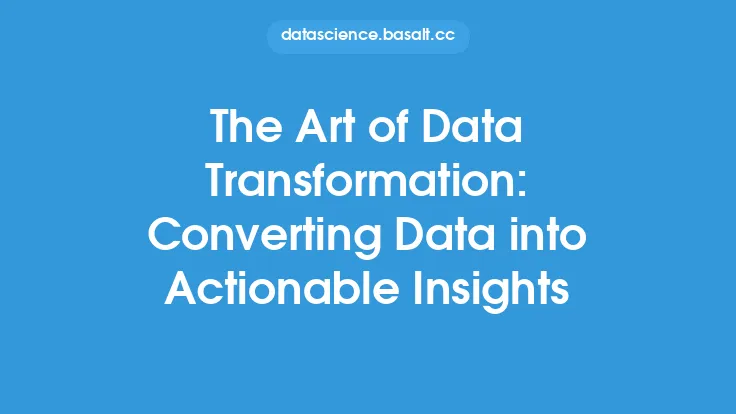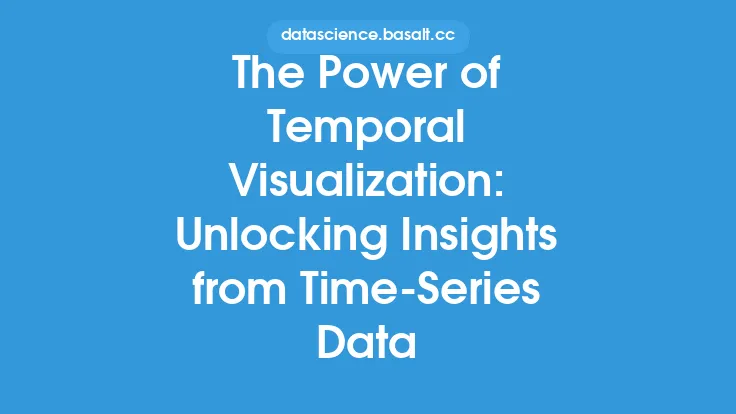The process of transforming raw data into actionable insights is a crucial step in the data analysis pipeline. It involves a series of complex tasks that require a combination of technical skills, business acumen, and attention to detail. At its core, data wrangling is about taking messy, unstructured, or incomplete data and turning it into a clean, organized, and structured format that can be used to inform business decisions or drive strategic initiatives.
Introduction to Data Wrangling
Data wrangling is a critical component of the data analysis process, and it involves a range of activities, including data cleaning, data transformation, and data formatting. The goal of data wrangling is to take raw data and convert it into a format that can be easily analyzed and interpreted. This process requires a deep understanding of the data, as well as the tools and techniques used to manipulate and transform it. Data wrangling is a time-consuming and labor-intensive process, but it is essential for extracting insights and value from data.
The Data Wrangling Process
The data wrangling process typically involves several stages, including data ingestion, data cleaning, data transformation, and data formatting. Data ingestion involves collecting and gathering data from various sources, such as databases, files, or external data providers. Data cleaning involves identifying and correcting errors, inconsistencies, and inaccuracies in the data. Data transformation involves converting the data into a format that is suitable for analysis, such as aggregating data, handling missing values, and performing data normalization. Finally, data formatting involves organizing the data into a structured format, such as a table or a data frame, that can be easily analyzed and interpreted.
Data Cleaning and Preprocessing
Data cleaning and preprocessing are critical steps in the data wrangling process. Data cleaning involves identifying and correcting errors, inconsistencies, and inaccuracies in the data. This can include handling missing values, removing duplicates, and correcting data entry errors. Data preprocessing involves transforming the data into a format that is suitable for analysis, such as converting data types, handling outliers, and performing data normalization. Data cleaning and preprocessing require a deep understanding of the data, as well as the tools and techniques used to manipulate and transform it.
Data Transformation and Formatting
Data transformation and formatting are essential steps in the data wrangling process. Data transformation involves converting the data into a format that is suitable for analysis, such as aggregating data, handling missing values, and performing data normalization. Data formatting involves organizing the data into a structured format, such as a table or a data frame, that can be easily analyzed and interpreted. Data transformation and formatting require a range of technical skills, including programming languages, such as Python or R, and data manipulation tools, such as pandas or NumPy.
Tools and Technologies for Data Wrangling
There are a range of tools and technologies available for data wrangling, including programming languages, such as Python or R, and data manipulation tools, such as pandas or NumPy. These tools provide a range of functions and features for data cleaning, data transformation, and data formatting. Additionally, there are a range of data wrangling platforms and software available, such as Trifacta, Talend, or Microsoft Power BI, that provide a range of features and functions for data wrangling. These platforms and software can help to streamline the data wrangling process, improve data quality, and reduce the time and effort required for data analysis.
Best Practices for Data Wrangling
There are several best practices for data wrangling, including documenting the data wrangling process, testing and validating the data, and using version control to track changes to the data. Additionally, it is essential to have a deep understanding of the data, as well as the tools and techniques used to manipulate and transform it. Data wrangling requires a range of technical skills, including programming languages, data manipulation tools, and data visualization tools. Furthermore, data wrangling requires a range of soft skills, including communication, collaboration, and problem-solving.
Common Challenges in Data Wrangling
There are several common challenges in data wrangling, including handling missing values, removing duplicates, and correcting data entry errors. Additionally, data wrangling can be a time-consuming and labor-intensive process, requiring a range of technical skills and a deep understanding of the data. Furthermore, data wrangling can be a complex and iterative process, requiring multiple rounds of data cleaning, data transformation, and data formatting. To overcome these challenges, it is essential to have a range of technical skills, including programming languages, data manipulation tools, and data visualization tools, as well as a range of soft skills, including communication, collaboration, and problem-solving.
Real-World Applications of Data Wrangling
Data wrangling has a range of real-world applications, including business intelligence, data science, and machine learning. In business intelligence, data wrangling is used to extract insights and value from data, informing business decisions and driving strategic initiatives. In data science, data wrangling is used to prepare data for analysis, building predictive models and identifying patterns and trends. In machine learning, data wrangling is used to prepare data for training and testing models, improving the accuracy and performance of machine learning algorithms. Additionally, data wrangling has applications in a range of industries, including healthcare, finance, and marketing, where it is used to extract insights and value from data, informing business decisions and driving strategic initiatives.
Conclusion
In conclusion, data wrangling is a critical component of the data analysis pipeline, involving a range of complex tasks that require a combination of technical skills, business acumen, and attention to detail. The data wrangling process typically involves several stages, including data ingestion, data cleaning, data transformation, and data formatting. Data cleaning and preprocessing are critical steps in the data wrangling process, requiring a deep understanding of the data, as well as the tools and techniques used to manipulate and transform it. Data transformation and formatting are essential steps in the data wrangling process, requiring a range of technical skills, including programming languages, data manipulation tools, and data visualization tools. By following best practices for data wrangling, including documenting the data wrangling process, testing and validating the data, and using version control to track changes to the data, organizations can improve the quality and accuracy of their data, informing business decisions and driving strategic initiatives.





